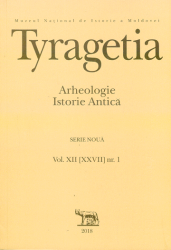Product Details
Cercetarile Sitului Arheologic Potarca din Rezervatia Cultural-Naturala Orheiul Vechi
-
Product Details
- Product #
- Author(s)
- Niculita, Ion
- City
- Chisinau
- Country
- Moldova
- Language
- Romanian
- ISBN
- 9789975335461
- Date of Publication
- 2019
- Publisher
- Cover Type
- Hard cover
- Pages
- 230
- Subject
- Archaeology
- Subject
- History, 19th Century and Earlier
-
Product Details in Original Language
- Author
- Publisher
-
Shipping
- USA Air
- $17.20
- Surface
- $11.70
- Non USA Air
- $17.20
-
Description
- The researches at the Potarca resort started in 1996, although the investigations at the archaeological objectives of the Iron Age, in the area of the current cultural-natural reserve "Orheiul Vechi" had been resumed 13 years earlier. The explanation for such a delay is simple – the normal inaccessibility to the site location. The Furceni promontory on which the Potarca settlement was built is situated at considerable distances from the current surrounding communities: Butuceni, Trebujeni and Furceni. Not only the lack of access routes, but also the most elementary possibilities of entering the area, do make almost impossible for a normal research of this archaeological objective. The Potarca settlement is located on the spur of the stone terrace of Furceni promontory, which is situated between the stream of the same name and Trebujeni commune in Codrii of Moldova. Surrounded on three parts by steep slopes, the altitude of which varies between 120 and150 m, it dominates the entire area of Raut River’s lower course. The Potarca site, which, like the terrace, had a triangular shape with inaccessible beds/sides, was almost invulnerable. From the defense system were preserved only the “wall” tracks currently visible in the form of ground waves, which in the form of a semicircle were barring the triangular terraces. The fortresses with one or two naturally protected sides, reinforced only in the vulnerable sector, fit perfectly into the category of “barred spur” sites. In the historiography of the second half of the last century, the settlements with a triangular or an almost triangular enclosure with a defensive barred base lines were considered the most widespread type of fortified sites during the 6th-3rd centuries BC. This assumption, over time, has proved to be groundless.
-
 Wish listBuy now
Identitatile Chisinaului : Editia a IV-a Materialele conferintei Internationale...
Wish listBuy now
Identitatile Chisinaului : Editia a IV-a Materialele conferintei Internationale...- Prod#:
- 5002387B
- Moldova; Chisinau: Editure Bons, 2018
- Romanian
 Wish listBuy now
Ariile naturale protejate din Moldova
Wish listBuy now
Ariile naturale protejate din Moldova- Prod#:
- 5005105B
- Moldova; Chisinau: Stiinta, 2016
- Romanian
 Wish listBuy now
Tyragetia : Serie Noua
Wish listBuy now
Tyragetia : Serie Noua- Prod#:
- 5006702B
- Moldova; Chisinau: Muzeul national de Arheologie si I..., 2018
- Romanian
- }







